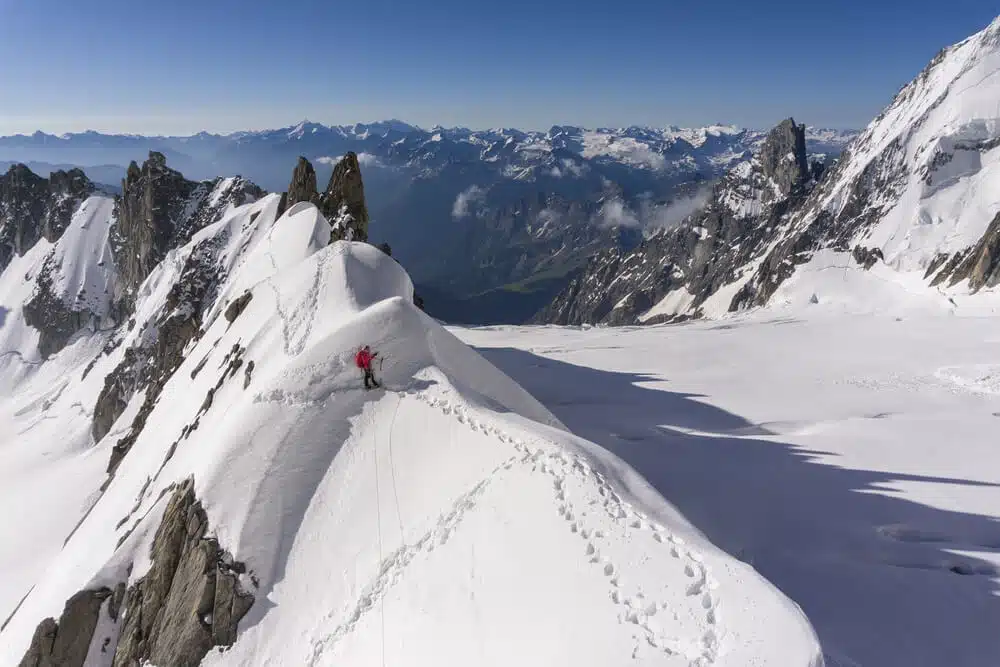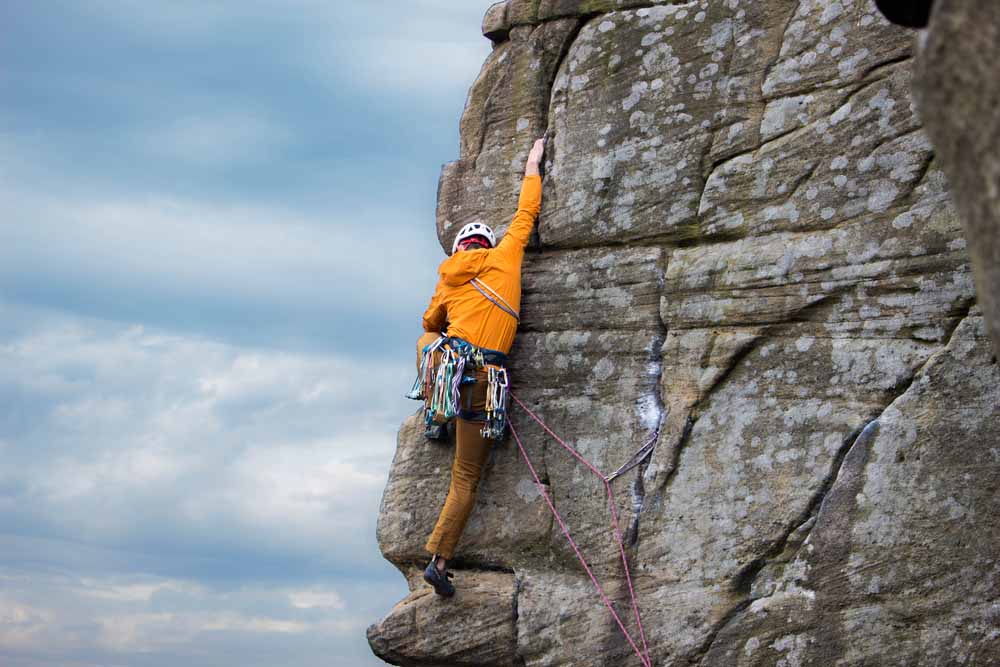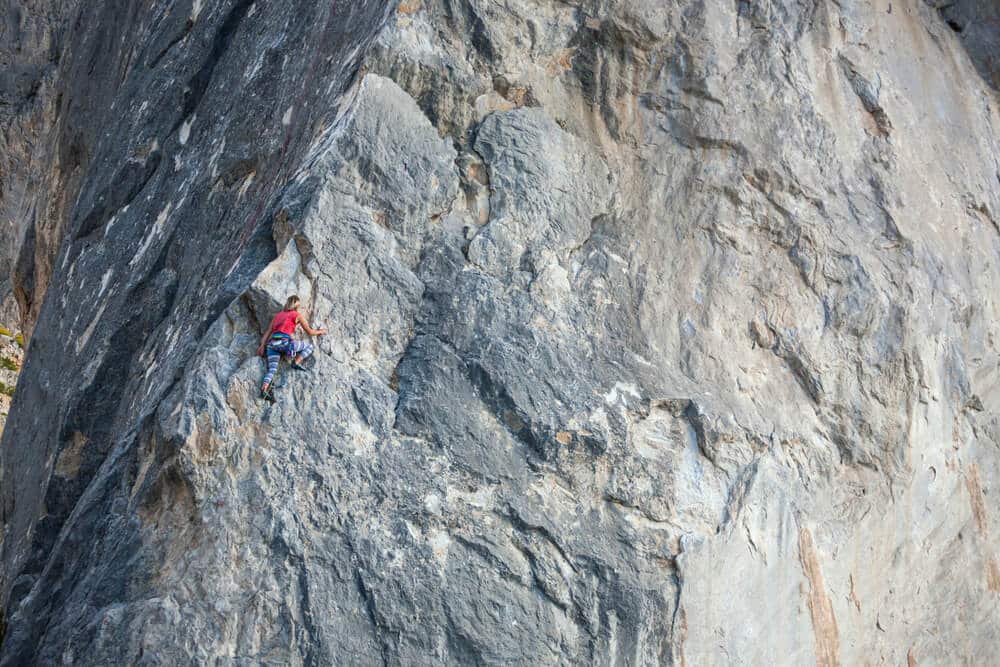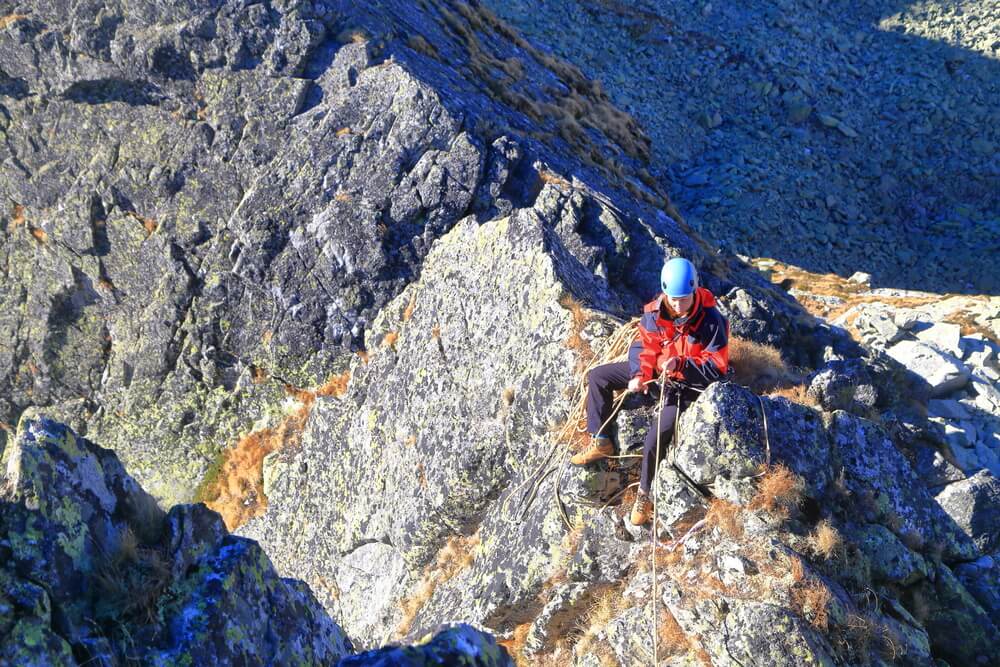The rock climbing world is rife with complex jargon, terms that can be almost indecipherable to non-climbers and beginners. One of these terms is arête (or arete, in common spelling).
Just like chimneying, working dihedrals, jamming cracks, and slab climbing, arete climbing is a unique and fulfilling aspect of our sport, something that all climbers should work on if they hope to progress in the sport.
What is a Geological Arête?
Most people don’t realize this, but a normal arête and an arete in climbing are two different things. The word “arête” is French, and in common usage, it refers to a sharp, prominent, narrow ridge separating two valleys formerly occupied by glaciers. The famous “Sawtooth” ridge between Mt. Bierdstadt and Mt. Evans in the Colorado Rockies is a perfect example. The Càrn Mòr Dearg arête leading to Scotland’s Ben Nevis is another.
Arêtes are characterized by their serrated crest and sheer sides. These are formed by the collapse of unsupported rock on either side, undercut by continual freezing and thawing from the previously existing glaciers that hemmed them in.
Arêtes don’t always culminate in a ridgeline. Sometimes aretes merge to form a high triangular peak (such as the Matterhorn). This happens when three or more glaciers erode toward each other.
What is an Arete in Rock Climbing?
An arête in rock climbing (spelled without the circumflex in American English) is a different thing, but the principle is the same. A climbing arete is the ridge or corner of a rock face, running vertically. In other words, it’s a vertical line where two separate rock faces meet.
Take those glacially-formed “arete” ridgelines we talked about in the previous section and run them upwards, vertically instead of horizontally. Now you have climbing aretes! If you’re having trouble picturing ate, just imagine the corner of a buildingasically an arete, too.
Aretes don’t always have to be at right angles, of course. Some are more obtuse and rounded, some more acute and sharp, almost a fin.
Arete climbing is a unique technique that requires as much technique and skill as strength. Footwork is key, and there is no sureproof system that will work for each section of an arete. As you progress up and arete, you’ll likely need to use a variety of techniques and swap body position from each face to the arete itself and back again. This is part of what makes arete climbing so enjoyable and fulfilling.
NOTE: The polar opposite of climbing aretes are “dihedrals.” Dihedrals are corners facing inwards, not outwards, and typically are climbed with stemming technique.
Trad Climbing, Sport Climbing, and Bouldering: Techniques for Arete Climbing

Smears
Smearing is the basic foot technique for ascending a featureless face, and it should be forefront in every climber’s toolkit for all rock climbing scenarios, not just aretes. To smear, you’ll use the ball of your foot to apply pressure to the rock and gain traction, pushing upwards.
Remember, the sticky rubber in your climbing shoes is what gives you grip. The more surface area you can get in contact with the wall (while keeping maximum pressure), the better traction you’ll get. Smears can come in handy if there are solid hand placements either along the arete or either face, but nowhere to put your feet. Trust that rubber!
Liebacks
Liebacking (or laybacking) is probably the most versatile technique in climbing, and it’s extremely useful on aretes. You can lieback an arete by gripping the edge and leaning back to one side, with your feet pushing against the face in front of you, as close to the same plane of pressure as where you’re gripping. (This sounds confusing, but when you’re on the wall, it’ll feel natural.)
Liebacking works by creating opposing pressure between the pull from your hands and the push from your feet. You’ll move upwards by alternating hands and feet. The benefit of liebacking is that most of your force comes from opposing hands and feet, pulling in a horizontal plane. This means you can get a lot of holding power with little to no footholds (smearing). Remember to get maximum rubber coverage for your feet as you lieback.
Hooking
Between solid hooking and liebacking, you have a real arsenal that can get you through most aretes. Hooking involves using your heel or toe to “hook” an edge, pulling back in with your hamstring (heel hook) or upwards with the top of your foot (toe hook) to create opposing force.
The corner of an arete is often well-positioned for hooking, especially while you’re liebacking with your hands. Trust that rubber and pull back directly, along the natural axis of your joints, instead of hooking with the sides of your feet or putting pressure at an angle. That’s how you’ll get the most power out of your hooks.
Bomber hooking doesn’t develop overnight, so you’ll have to put some work into this technique, but it’s invaluable on aretes.
Tips and Tricks for Arete Climbing
Legs, Legs, Legs!
Aretes are a footwork-heavy feature. Arete climbing is one of the only scenarios in climbing where you’ll really engage your adductors (the muscles running along the inside of your thighs) to create tension between your legs.
Sometimes you’ll have both feet on one side of the face, but in certain scenarios you’ll have one on each side, straddling the arete. Avoid completely hugging the wall in these scenarios. Instead, rely on contact with your hands and feet, but remember to engage those adductor muscles to provide inward tension as well.
Watch Your Rope
When you ascend an arete while lead climbing, watch the position of your climbing rope at all times. Because you’ll often be moving your legs between two different rock faces and back again while on an arete rock climbing route, the rope can easily become snagged on edges or caught behind your legs.
Most climbers know this, but having your rope running behind your leg can flip you upside down (and likely smack your head) in the event of a fall. So make sure the rope is properly positioned at all times. This can take careful consideration because the arete can often block your field of view if your feet and rope are on the opposite side of your upper body.
For the same reason, watch out for z-clipping or backclipping your draws if sport climbing. You’ll sometimes be clipping bolts on the opposite side of the arete, out of view.
If trad climbing, be especially careful about placing pro on both sides of the arete. This isn’t just a problem because of rope drag. It can also cause the rope to run over the sharp edges of the arete, increasing the risk of your rope cutting if you take a high factor fall.
Barn Dooring
Barn dooring occurs when your weight is poorly positioned relative to your hand and foot placements, causing you to swing out to one side (like a barn door). Arete climbing often leads to barn dooring, because you’re often positioned at odd angles, using lateral pressure to move upwards.
You’re constantly shifting position on an arete rock climb, so it’s easy to get off balance like this. To avoid barn dooring, keep your weight centered as you move, and make sure that for every force you apply to the rock in a lateral direction, there’s an equal amount of force being applied in the opposite direction. If you feel the urge to swing, techniques like heel and toe hooks are especially good at preventing this.
Check the Edge?
If you have no other option, the best way to climb an arete could be to catwalk up the knife-edge of the arete itself. This typically is only possible if the arete is low angle, closer to a steep ridge than a true vertical arete, but it’s certainly something to try if you’ve exhausted other strategies.
Is Arete Climbing Dangerous?
Free climbing on an arete isn’t any more dangerous than anything else in climbing. The biggest concern with climbing is rope management. As we mentioned above, your rope can easily get caught around your leg on an arete, and placements can be trickier on aretes. Avoid having the rope run back and forth between each face.
Falling can result in swings on aretes, such as if you’re climbing on one side and your pro is on the other. Avoid getting too far away from your last piece of pro, particularly on the opposite face of the arete. If you stay alert and focused though, arete climbing isn’t anything to be afraid of.
















